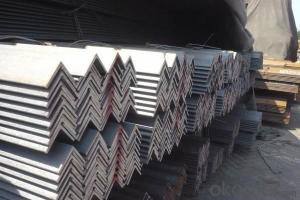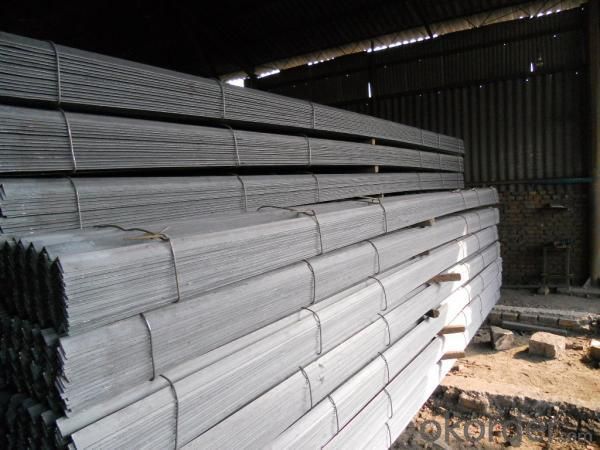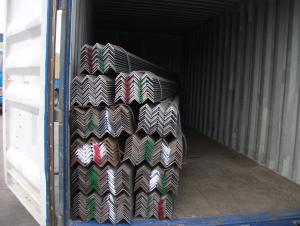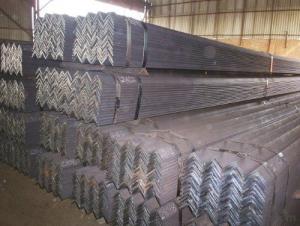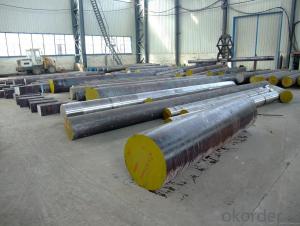JIS SS400 Angle Steel
- Loading Port:
- Tianjin
- Payment Terms:
- TT OR LC
- Min Order Qty:
- 1000 m.t.
- Supply Capability:
- 10000 m.t./month
OKorder Service Pledge
OKorder Financial Service
You Might Also Like
Specifications of JIS SS400 Angle Steel
1.Standards:GB,ASTM,BS,AISI,DIN,JIS
2.Invoicing on theoretical weight or actual weight as customer request
3.Material: JIS G3192,SS400;SS540.
4. Payment terms:
1).100% irrevocable L/C at sight.
2).30% T/T prepaid and the balance against the copy of B/L.
3).30% T/T prepaid and the balance against L/C
5.Sizes:
EQUAL ANGLES SIZES | |||
a(mm) | a1(mm) | thickness(mm) | length |
25 | 25 | 2.5---3.0 | 6M/12M |
30 | 30 | 2.5---4.0 | 6M/12M |
38 | 38 | 2.5 | 6M/12M |
38 | 38 | 3.0---5.0 | 6M/12M |
40 | 40 | 3.0---6.0 | 6M/12M |
50 | 50 | 3 | 6M/12M |
50 | 50 | 3.7---6.0 | 6M/9M/12M |
60 | 60 | 5.0---6.0 | 6M/9M/12M |
63 | 63 | 6.0---8.0 | 6M/9M/12M |
65 | 65 | 5.0---8.0 | 6M/9M/12M |
70 | 70 | 6.0---7.0 | 6M/9M/12M |
75 | 75 | 5.0---10.0 | 6M/9M/12M |
80 | 80 | 6.0---10.0 | 6M/9M/12M |
90 | 90 | 6.0---10.0 | 6M/9M/12M |
100 | 100 | 6.0---12.0 | 6M/9M/12M |
120 | 120 | 8.0-12.0 | 6M/9M/12M |
125 | 125 | 8.0---12.0 | 6M/9M/12M |
130 | 130 | 9.0-12.0 | 6M/9M/12M |
140 | 140 | 10.0-16.0 | 6M/9M/12M |
150 | 150 | 10---15 | 6M/9M/12M |
160 | 160 | 10---16 | 6M/9M/12M |
180 | 180 | 12---18 | 6M/9M/12M |
200 | 200 | 14---20 | 6M/9M/12M |
5. Material Specifications:
Grade | Yield Strength,N/mm² | Extension Strength N/mm² | |||
Thickness of Steel,mm | |||||
≦16 | >16-≦40 | >40-≦100 | >100 | ||
SS330 | ≧205 | ≧195 | ≧175 | ≧165 | 330-430 |
SS400 | ≧245 | ≧235 | ≧215 | ≧205 | 400-510 |
SS490 | ≧285 | ≧275 | ≧255 | ≧245 | 490-610 |
SS540 | ≧400 | ≧390 | - | - | ≧540 |
Usage & Applications JIS SS400 Angle Steel
Trusses;
Transmission towers;
Telecommunication towers;
Bracing for general structures;
Stiffeners in structural use.
Packaging & Delivery of JIS SS400 Angle Steel
1. Transportation: the goods are delivered by truck from mill to loading port, the maximum quantity can be loaded is around 40MTs by each truck. If the order quantity cannot reach the full truck loaded, the transportation cost per ton will be little higher than full load.
2. With bundles and load in 20 feet/40 feet container, or by bulk cargo, also we could do as customer's request.
3. Marks:
Color mark: There will be color marking on both end of the bundle for the cargo delivered by bulk vessel. That makes it easily to distinguish at the destination port.
Tag mark: There will be tag mark tied up on the bundles. The information usually including supplier logo and name, product name, made in China, shipping marks and other information request by the customer.
If loading by container the marking is not needed, but we will prepare it as customer request.
Production flow of JIS SS400 Angle Steel
Material prepare (billet) —heat up—rough rolling—precision rolling—cooling—packing—storage and transportation
- Q: What is the typical shear strength of steel angles?
- The typical shear strength of steel angles can vary depending on several factors such as the grade of steel, the size and shape of the angle, and the specific application or industry standards being followed. However, in general, steel angles are known for their high shear strength. For standard structural steel angles, the shear strength can range from approximately 50,000 pounds per square inch (psi) to 75,000 psi. This range applies to common steel grades such as A36, A572, and A588. These angles are commonly used in construction, infrastructure, and engineering projects where shear forces are a concern. It is important to note that the shear strength of steel angles can be influenced by other factors such as the presence of holes or notches, welding or fabrication processes, and the overall design and load distribution. Therefore, it is crucial to consult relevant design codes or engineering specifications to determine the specific shear strength requirements for a given application. It is also recommended to consult with a structural engineer or experienced professional to ensure the accurate determination of shear strength for steel angles in a particular project.
- Q: Are steel angles suitable for constructing bridges?
- Indeed, bridges can be constructed using steel angles. Due to their strength and versatility, steel angles are frequently employed in bridge construction. They can easily be fashioned into different forms and dimensions, making them well-suited for crafting structural elements like beams, columns, and trusses. Moreover, steel angles possess exceptional tensile strength, enabling them to endure the weighty loads and forces endured by bridges. Furthermore, steel angles boast excellent resistance to corrosion, guaranteeing the endurance and resilience of bridge structures. In summary, steel angles represent a dependable and economical option for bridge construction.
- Q: What is the angle iron back machine?
- The process of removing the right angle of the angle steel is to shovel back, also called shovel edge. The traditional machining and low production efficiency, high labor intensity, the company through a large number of technological innovation, design and manufacture of efficient continuous feeding (limited length) of the TGC200 series CNC shoveling machine, can fully meet the demand of processing in shoveling tower.
- Q: Can steel angles be used as structural members?
- Certainly, structural members can utilize steel angles. In construction and engineering endeavors, steel angles are frequently employed to furnish structural reinforcement and stability. They are commonly utilized to fortify and enhance an assortment of structures, including edifices, bridges, and frameworks. Renowned for their robustness and endurance, steel angles are highly suitable for structural applications. They can be utilized either in combination with other steel components or independently to bear or distribute loads, bolster beams, and confer stability to the overall structure. Moreover, steel angles can be conveniently fabricated and installed, rendering them a versatile and cost-effective choice for structural members in diverse construction projects.
- Q: How do you reinforce a steel angle?
- One way to reinforce a steel angle is by adding additional structural elements such as steel plates or gussets. These can be welded or bolted onto the angle to increase its strength and load-bearing capacity. Additionally, using thicker and higher-grade steel angles can also provide increased reinforcement.
- Q: Can steel angles be used for HVAC ductwork?
- No, steel angles are not typically used for HVAC ductwork. Ductwork is commonly made from galvanized steel sheets or flexible materials such as aluminum or fiberglass. Steel angles are more commonly used for structural support or framing purposes.
- Q: Are steel angles suitable for manufacturing equipment enclosures?
- Indeed, steel angles prove to be an appropriate choice for the fabrication of equipment enclosures. Given their robustness and enduring nature, steel angles are widely utilized in both construction and manufacturing sectors. They furnish a solid framework for enclosing equipment and can be effortlessly joined through welding or bolting to ensure a secure enclosure. Moreover, steel angles can be tailored to suit precise dimensions and can be effortlessly adjusted or extended if necessary. In summary, steel angles present a dependable and economically viable solution for the production of equipment enclosures.
- Q: How do you determine the required angle size for a specific load?
- Several factors must be taken into account in order to determine the necessary angle size for a specific load. Firstly, the weight of the load needs to be established. This can be achieved by either measuring the object's mass or consulting relevant engineering specifications. Secondly, it is crucial to know the angle of inclination or the slope at which the load will be placed. The angle of inclination will impact both the force exerted on the angle and the stability of the load. Furthermore, the type and material of the angle being used should be considered. Different materials have varying load-bearing capacities, and the type of angle (e.g., steel, aluminum, or wood) will dictate its maximum load-bearing ability. In addition, the length of the angle and the number of supporting points should be taken into consideration. Longer angles may require extra support to evenly distribute the load and prevent bending or deformation. Once all of these factors have been determined, engineering formulas and principles can be utilized to make calculations. These calculations will take into account the weight of the load, the angle of inclination, and the material properties of the angle to determine the required angle size. It is important to note that, when designing for safety, engineers typically incorporate a factor of safety to ensure that the angle can handle loads exceeding the expected maximum. This factor accounts for variables such as dynamic loads, unforeseen circumstances, and wear and tear over time. In conclusion, determining the necessary angle size for a specific load involves considering the weight of the load, the angle of inclination, the material properties of the angle, the length of the angle, and the number of supporting points. Through calculations and incorporating a factor of safety, the appropriate angle size can be determined to ensure the load is supported safely and effectively.
- Q: What are the design standards for steel angles?
- The design standards for steel angles depend on the specific application and industry requirements. However, there are some general design standards that are commonly followed in the construction and engineering fields. One important aspect is the dimensional and mechanical properties of the steel angles. These properties include the angle's size, thickness, length, and weight. The dimensions are typically specified in millimeters or inches, and the mechanical properties determine the angle's strength and load-bearing capacity. In terms of shape, steel angles are typically L-shaped with equal or unequal legs. The equal-legged angles have two legs of the same length, while unequal-legged angles have two legs of different lengths. The angle's shape and geometry play a crucial role in determining its structural integrity and stability. Another important consideration is the material specification for the steel angles. The material used for fabrication should meet certain standards, such as the American Society for Testing and Materials (ASTM) specifications, to ensure the required strength, ductility, and toughness. Commonly used materials for steel angles include carbon steel, stainless steel, and alloy steel. The design standards for steel angles also include guidelines for connection details. These details specify the method of connecting the angles to other structural members, such as beams, columns, or plates. The connection details ensure proper load transfer and structural stability, and they may involve welding, bolting, or other mechanical fastening methods. Additionally, design standards may include guidelines for the design of steel angle members subjected to specific loads, such as axial compression, bending, or shear. These guidelines provide formulas, charts, and design tables that allow engineers to calculate the required size and strength of the angle based on the applied loads and other factors. Overall, the design standards for steel angles ensure that these structural members meet specific requirements in terms of dimensions, material properties, shape, and connection details. These standards help ensure the safety, reliability, and performance of steel angles in various applications, ranging from building construction to industrial machinery.
- Q: How do steel angles contribute to LEED certification?
- There are several ways in which the use of steel angles can contribute to LEED certification, which is the Leadership in Energy and Environmental Design. Firstly, the production of steel angles often involves the use of recycled steel, reducing the need for new materials and lessening the environmental impact of steel production. Secondly, steel angles have a long lifespan and are highly durable, resulting in reduced maintenance and replacement needs. This, in turn, leads to a decrease in waste generated throughout a building's lifecycle, thus earning LEED credits for minimizing construction and demolition waste. Furthermore, steel angles can be utilized to create efficient structural systems that allow for open and adaptable building designs. This aspect qualifies for LEED recognition in the Innovation in Design category, highlighting exceptional energy and resource efficiency. Additionally, integrating steel angles into a building's design is a straightforward process, making it easier to support sustainable features like solar panels, green roofs, or rainwater harvesting systems. These environmentally friendly features are instrumental in achieving LEED credits for energy efficiency, renewable energy, and water efficiency. In conclusion, the utilization of steel angles in construction contributes to LEED certification through their use of recycled materials, provision of durability and longevity, facilitation of efficient structural systems, and support for sustainable features integration.
Send your message to us
JIS SS400 Angle Steel
- Loading Port:
- Tianjin
- Payment Terms:
- TT OR LC
- Min Order Qty:
- 1000 m.t.
- Supply Capability:
- 10000 m.t./month
OKorder Service Pledge
OKorder Financial Service
Similar products
Hot products
Hot Searches
Related keywords
